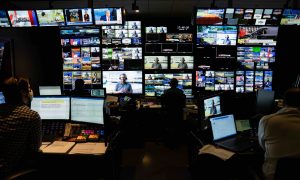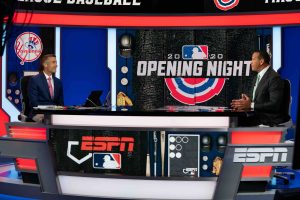MLB Returns: ESPN Operations Solves Logistical Puzzle on Rain-Shortened Opening Day
With a comprehensive plan, ESPN’s ops team is staying afloat amid a 60-game season
Story Highlights
Thursday, July 23 was a day that has been circled on ESPN employees’ calendars for quite some time. With Opening Day of this peculiar, 60-game Major League Baseball regular season in the rearview mirror, the operations team can recollect their thoughts, assess any pitfalls, and regroup before the rest of the 2020 schedule unfolds.
“As part of the new world that we’re in now, MLB did a great job at getting everybody on the same page early on,” says Paul Horrell, remote operations manager, ESPN. “They came up with a scenario that would satisfy all broadcasters while minimizing the logistics and the travel and onsite needs. There are a lot of moving targets, and [ESPN] tried to create something that would best protect us across the board.”
Producing From Afar: A ‘World Feed’ for Domestic Distribution
While COVID-19 still has the country in a fierce stranglehold, the league is giving ballpark and television-compound access only to the home-team regional sports network. Taking a page out of the playbook of international competitions like the World Cup and the Olympics, these RSNs will supply a clean and more-neutral feed for use on national broadcasts by ESPN, Fox Sports, and TBS.

Inside the control room during the Opening Day game between the Washington Nationals and New York Yankees (Photo by Kelly Backus / ESPN Images)
“For non-exclusive games, we’re taking the world feed from the truck of the home RSN truck and augmenting it with one or two onsite cameras that are dedicated to ESPN,” says Horrell. “Those cameras are taken on iso fiber paths to Bristol through our REMI model. The director in Bristol has control over those two cameras, and they use those two camera angles to cut in and out of the world feed.”
In addition to these exclusive cameras on weekday telecasts, extra technical enhancements, including additional replay operators and a total of 20 cameras (compared with the six or seven on weekday contests), are in play for the Sunday Night Baseball property. Nonetheless, the MLB department of ESPN is not familiar with the world-feed approach. As the production side continues to deal with and overcome the challenges of this truncated season. The operations side has also become more battle-hardened and resilient.
“There are nine or 10 hard cameras, an RF handheld, POVs in the bullpen, and various robos,” Horrell adds. “There are a lot of different factors and little technical ‘gotchas’ along the way. [For example], depending on how things are on a week-to-week basis and the size of the ballpark that we’re in, [our camera complement] will be one of the unknowns.”
Shipping to Bristol: Onsite Uplink Truck Alleviates Strain on Transmission
A welcome sign to the industry, the broadcaster’s schedule is getting busier by the day with the postseason section of the MLS Is Back Tournament under way, the commencement of the 22-game WNBA season this past weekend, and the upcoming return of the NBA on July 30. Though a blessing, the busy schedule poses a large logistical challenge. On the technological front, the operations team is condensing its onsite video sources into singular paths to decongest transmission paths used for coverage of the two other professional leagues.
“We have some limitations with the amount of throughput and hardware that is available in Bristol since there are sports that are returning and a lot of them taking either REMI or GREMI [remote graphics] approaches,” says Horrell. “In order to alleviate some of the congestion, we’re taking those 20 sources [for exclusive Sunday games] and putting them through a small uplink truck, which has MUX hardware on it. Basically, 10 camera paths can be condensed down to a single fiber, so we’re taking the first 10 camera sources through MUX 1 and the second 10 camera sources through MUX 2.”

Matt Vasgersian (left) and Alex Rodriguez (right) call the action from a studio at ESPN’s facility in Bristol, CT. (Photo by Kelly Backus / ESPN Images)
For extra redundancy, a third fiber is being used as a backup as well as a private path for key camera angles to free space on the inbound line to Bristol. After receiving these feeds, the Bristol-based team can unpack them into their original 20 sources. Although a viable solution, this strategy came with a small hurdle that needed to be accounted for on Opening Day.
“This new model comes with the associated delays in everything,” says Horrell. “When you’re shipping 20 iso sources back to Bristol, there is a delay factor, so you have to reset your timeline. It also gets complex when you’re having to feed some of those sources to your home[-based] talent and figuring out the round-trip delay and the different delays between your talent.”
Along with figuring out how to ship video, audio, and other ancillary feeds to the mothership and to talent working from their respective homes, strategizing where to locate on-air personalities and behind-the-scenes staff while adhering to COVID-19 health and safety guidelines is another piece to the enormous puzzle that ESPN is slowly putting together.
“The team in Bristol is very much aware of [social distancing] by spreading employees out in different control rooms and media rooms,” Horrell says. “There are restrictions on the number of people coming into the building. [On Opening Day], we did have back-to-back games, so there were multiple PCRs in play for that.”
Thunderstruck: Communication With MASN Helps Team Navigate Nasty Weather

Headsets, including this one belonging to Matt Vasgersian, are labeled to prevent cross-contamination and follow stringent COVID-19 safety guidelines. (Photo by Kelly Backus / ESPN Images)
The Washington Nationals’ Opening Day matchup against the New York Yankees was MASN’s first foray with the world feed. The initial broadcast of the 2020 season was the first of back-to-back nationally televised games. Receiving the camera feeds in Bristol, ESPN had to rely on the RSN to make any major onsite decisions and maintained constant communication with the RSN boots on the ground.
This added wrinkle would become important when lightning entered the vicinity of Nationals Park, forcing some camera positions to be shut down per onsite safety protocol. This was only a precursor of what was to come: the lightning was followed by the skies’ opening up with a torrential downpour.
“I had one of my operations producers onsite: John Winders, who is one of my regulars for Sunday Night Baseball,” says Horrell. “ESPN uses a program for weather and lightning alerts, and I preconfigure and put the appropriate people on it for every game. When we do get into a weather or lightning situation, they get the automatic updates from the weather system.”
Teamwork Makes the Dream Work: Internal, External Cooperation
Although no one knows the exact answers, innovation and a passion for pleasing the fans watching at home are inspiring the execution of a season being played in never-before-seen circumstances. And, although potential brain-busting questions lie ahead, cooperation by all will make this effort worthwhile and possible.
“Instead of asking ‘What’s different this year?’” says Horrell, “I think the shorter question would be ’What’s the same?’ because we don’t have our usual trucks and crew and it’s a completely different workflow. There has been great cooperation across the board — internally and externally with MLB and all of the RSNs — but you have to do what you have to do to face an unknown challenge. My remote-operations team has been absolutely fantastic because we had to take our standard tech survey and deconstruct that in order to be REMI-friendly.”
ESPN’s MLB coverage continues with a weekday doubleheader of Colorado Rockies vs. Oakland Athletics at 4 p.m. ET and Los Angeles Dodgers vs. Houston Astros as 7 p.m. on Wednesday, July 29. Sunday Night Baseball returns with an AL East rivalry between the New York Yankees and Boston Red Sox in the Bronx at 7 p.m. on Sunday, Aug. 2.
